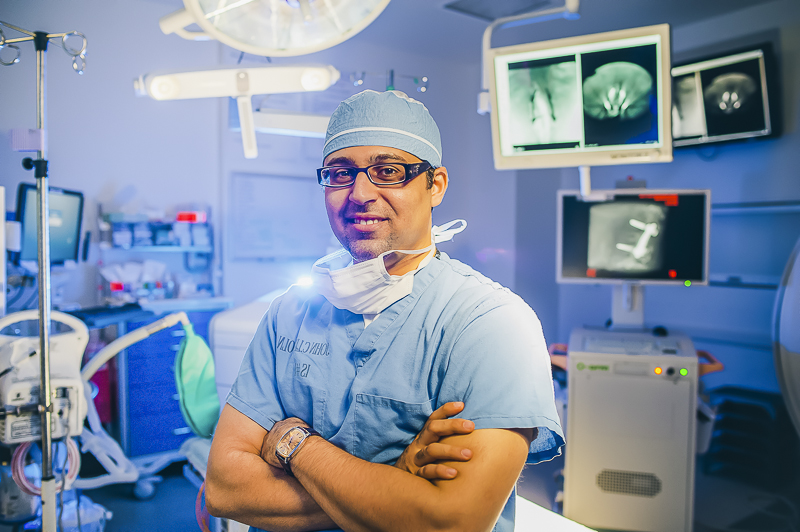Scottsdale, Arizona
Royal Spine Surgery
Dr. Mohamed Abdulhamid is a neurosurgeon specializing in the diagnosis, management, and treatment of disorders of the brain and spine. Dr. Abdulhamid provides consultation in the fields of neurosurgery and spine surgery.

WHAT ARE THE THREE MOST COMMON BACK SURGERY TYPES?
Having back surgery is a big commitment, and many people are overwhelmed by the thought of undergoing such an invasive procedure. Fortunately, most back surgeries fall into three main categories, which doctors perform regularly with positive results. Here's a look at three of the most common back surgery types so you'll know what to expect.
Laminectomy
Laminectomy is an invasive surgery that is done to treat a condition called spinal stenosis. This occurs when your spine has compressed and put pressure on your nerves, causing pain. The process of laminectomy requires exposing the affected area of the spine and removing bits of bone and ligaments that could be causing the pressure. This also involves removing any bone spurs that may have grown in the area. Unfortunately, if the laminectomy requires significant bone removal, it is possible that your spine will be destabilized, requiring further treatment in the form of a spinal fusion.
Spinal Fusion
Spinal fusion is used in cases where the spine needs to be strengthened or stabilized to prevent unwanted movement. This is often the case if the vertebrae are grinding against one another or if movement causes pinching of nerves. In this process, a series of screws are inserted into the affected vertebrae, along with a couple of guide cables. As they are tightened, the vertebrae are pulled into position and held steady. Then, bone grafts or special cements will be used to fuse the vertebrae into position so that they cannot move against one another. This process is typically done in small groups, ensuring that you are still able to bend and move flexibly with few limitations. If spinal fusion is required after laminectomy, your doctor will likely perform both procedures together.
Discectomy
The third of the common back surgery types is discectomy. The spinal disc is a soft pad that provides cushioning between your vertebrae. It allows your vertebrae to move without grinding, while also providing a channel for your spinal cord to pass safely through. With some spinal injuries, a disc may slide out of place from between two vertebrae, causing it to bulge and pull on the spinal cord. Depending on the severity of the injury, this surgery may be done through a large incision or with the help of microscopic equipment, limiting the size of the incision and your recovery time. A discectomy requires removing all or part of the affected disc. Your doctor may choose to perform a disc replacement using an artificial disc, which will fill the space between the vertebrae and preserve your flexibility.
While there are several other back surgery types in use today, these three are the most common procedures for patients today. New technology is making it possible to perform these procedures with minimal invasiveness. However, any surgical procedure done on the spine is a major procedure that requires great care. To learn more about back surgery types and treatment options today, contact Royal Spine.
Check out some testimonials from our patients, and then contact us today to learn more.
Related Links:
neurosurgeon
neurosurgery
neurological surgery
spinal surgery
minimally invasive spinal surgery
arizona brain and spine center
arizona brain and spine
arizona neurosurgery and spine
arizona neurosurgery
neuro spine
neurosurgeon phoenix
phoenix neurosurgeon
dorsalgia
what is dorsalgia
lumbago
cervicalgia
disc rupture
Videos: https://www.royalspinesurgery.com/media1/mission-vision/
<iframe width="560" height="315" src="https://www.youtube.com/embed/3hmLRXHuNAA" frameborder="0" allow="accelerometer; autoplay; encrypted-media; gyroscope; picture-in-picture" allowfullscreen></iframe>
https://youtu.be/3hmLRXHuNAA
Location:
9377 E Bell Rd #343, Scottsdale, AZ 85260
480-424-5255
Keywords: neurosurgeon, neurosurgery, neurological surgery, spinal surgery, minimally invasive spinal surgery, arizona brain and spine center, arizona brain and spine, arizona neurosurgery and spine, arizona neurosurgery, neuro spine, neurosurgeon phoenix, phoenix neurosurgeon, dorsalgia, what is dorsalgia
Infographic: https://medium.com/@royalspinesurgery/what-is-dorsalgia-565e5075a74b

ROYAL SPINE SURGERY
HAVE YOU BEEN TOLD YOU NEED A SPINAL PROCEDURE BY YOUR PHYSICIAN?
After completing seven years of neurosurgical residency training, Dr. Mohamed Abdulhamid dedicated a full year of fellowship training to the field of spine surgery, including minimally invasive spine surgery. He has been able to successfully manage and treat various conditions of the spine, including degenerative spine conditions, trauma, tumor, infection, and revision, utilizing minimally invasive spine surgery and GPS spine navigation technology.
ROYAL SPINE SURGERY
NEED A SECOND OPINION?
Dr. Abdulhamid welcomes those patients seeking a second opinion. Regardless of the type of condition you have or procedure you are being offered, he will provide you with an unbiased opinion based on his assessment and evaluation. While it is not a requirement, please keep in mind that a second opinion could only be fully complete with an in-person visit in the clinic with him.

Professionalism, expertise and “the best in his field,”Testimonial

GET IN TOUCH
REQUEST AN APPOINTMENT
A visit to a neurosurgeon is undoubtedly associated with feelings of anxiety, apprehension, and fear. It also raises a multitude of worrisome questions, concerns, and uncertainties to patients and their families. Dr. Abdulhamid understands what such an important visit means to you.

